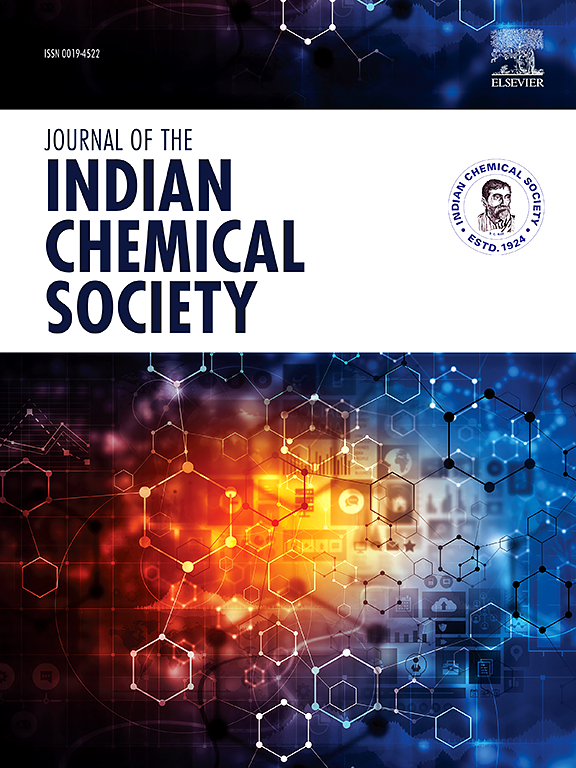Anthracite/talc-based porous activated composite loaded with DTAB surfactant for Cr(VI) adsorption: Characterization, performance, and mechanism
IF 3.2
4区 化学
Q2 CHEMISTRY, MULTIDISCIPLINARY
引用次数: 0
Abstract
A mixture of anthracite (An) and heated talc (HT) was activated with sodium silicate and then coated with dodecyltrimethylammonium bromide (DTAB) to prepare a new porous adsorbent (DTAB-HT/An) for removing Cr(VI) from solutions. FTIR, zeta potential, FESEM/EDX, and XRD methods demonstrated the effective modification of the adsorbent by the DTAB surfactant. The efficiency of DTAB-HT/An in removing Cr(VI) ions was enhanced to 91 % by DTAB support at the optimum pH of 3.0, as compared to 62 % of the untreated HT/An blend. Within the range of 25–55 °C, the adsorption data were fitted using conventional models, and the maximum capacities, as calculated by the Langmuir equation, varied between 162.60 and 124.03 mg/g. Furthermore, the density of DTAB-HT/An energetic sites, the elimination capacities at saturation, and the amount of Cr(VI) removed by each functional group were all analyzed though the statistical physics theory. The removal of Cr(VI) was found to be dominated by dissimilar mechanisms (i.e., surface complexation, pore filling, and electrostatic attraction), according to the experiments and theoretical studies. Over the adsorption process, Cr(VI) and Cr(III) displayed distinct geometric behaviors (mixed or vertical orientation) and interaction mechanisms (multi-docking or multi-ionic). Energetic and thermodynamic functions suggested that the adsorption system was exothermic and directed by a spontaneous mechanism. Based on the regeneration results up to six cycles, the DTAB-HT/An was really stable and appropriate in wastewater treatment.

负载DTAB表面活性剂的无烟煤/滑石基多孔活性复合材料吸附Cr(VI):表征、性能及机理
以水玻璃活化无烟煤(An)和加热滑石粉(HT)的混合物,然后包覆十二烷基三甲基溴化铵(DTAB),制备了一种新型多孔吸附剂(DTAB-HT/An),用于去除溶液中的Cr(VI)。FTIR、zeta电位、FESEM/EDX和XRD等方法均证实了DTAB表面活性剂对吸附剂的有效改性。在最佳pH为3.0时,DTAB-HT/An对Cr(VI)离子的去除率达到91%,而未处理的HT/An共混物的去除率为62%。在25 ~ 55℃范围内,采用常规模型拟合吸附数据,根据Langmuir方程计算出的最大吸附量在162.60 ~ 124.03 mg/g之间。利用统计物理理论分析了DTAB-HT/ a的能位密度、饱和时的消除能力以及各官能团对Cr(VI)的去除量。通过实验和理论研究发现,Cr(VI)的去除主要由不同的机制(即表面络合、孔隙填充和静电吸引)所主导。在吸附过程中,Cr(VI)和Cr(III)表现出不同的几何行为(混合取向或垂直取向)和相互作用机制(多对接或多离子)。能量和热力学函数表明,该吸附体系为放热吸附,受自发吸附机制支配。6次循环再生结果表明,DTAB-HT/An在废水处理中具有较好的稳定性和适用性。
本文章由计算机程序翻译,如有差异,请以英文原文为准。
求助全文
约1分钟内获得全文
求助全文
来源期刊
CiteScore
3.50
自引率
7.70%
发文量
492
审稿时长
3-8 weeks
期刊介绍:
The Journal of the Indian Chemical Society publishes original, fundamental, theorical, experimental research work of highest quality in all areas of chemistry, biochemistry, medicinal chemistry, electrochemistry, agrochemistry, chemical engineering and technology, food chemistry, environmental chemistry, etc.

 求助内容:
求助内容: 应助结果提醒方式:
应助结果提醒方式:


